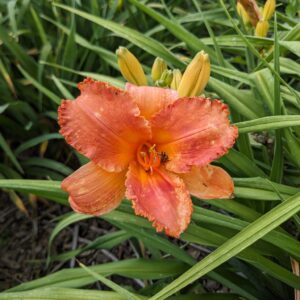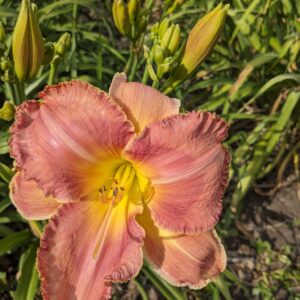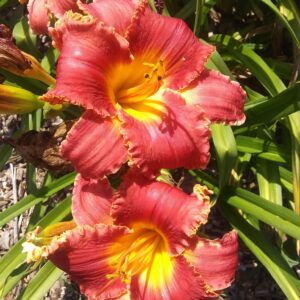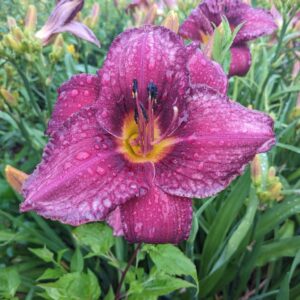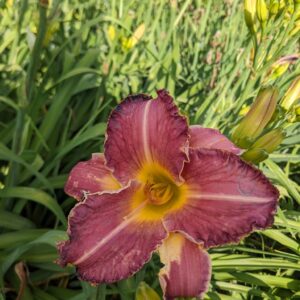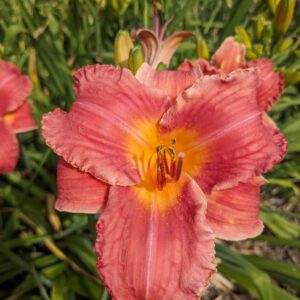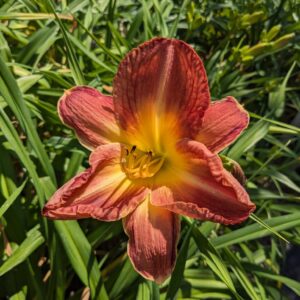Perennials & Biennials
Showing 233–240 of 511 results
-
Hemerocallis ‘Marmalade Skies’ Z 4-8
Tetraploid Daylily. Blossoms the color of pink glazed with tangerine and ruffled petal edges with contrasting straight edged sepals. enclosed by a thin line of yellow. Blossoms enveloping its glowing eye, Blooms in July.
Tetraploid Daylily. Blossoms the color of pink glazed with tangerine and ruffled petal edges with contrasting straight edged sepals. enclosed by a thin line of yellow. Blossoms enveloping its glowing eye, Blooms in July.
Size: 26-30” tall. Blossoms 5.5” across.
Care: sun in most any soilTetraploid Daylily. Blossoms the color of pink glazed with tangerine and ruffled petal edges with contrasting straight edged sepals. enclosed by a thin line of yellow. Blossoms enveloping its glowing eye, Blooms in July.
-
Hemerocallis ‘Orange Taffy’
Broad coral petals with sunshine throat and ruffled petal edges.
Tetraploid daylily. Our own hybrid. Flowers in July.
Broad coral petals with sunshine throat and ruffled petal edges.Size: 20-30” tall
Care: Full sunOur own hybrid
-
Hemerocallis ‘Plum Souffle’ Z 4-8
Tetraploid Daylily. Blossoms the color of pink streaked lavender with ruffled edges and a golden, glowing eye, Blooms in July.
Tetraploid Daylily. Blossoms the color of pink streaked lavender with ruffled edges and a golden, glowing eye, Blooms in July.
Size: 26-33”” tall. Blossoms 5” across.
Care: sun in most any soilTetraploid Daylily. Blossoms the color of pink streaked lavender with ruffled edges and a golden, glowing eye, Blooms in July.
-
Hemerocallis ‘Pretty Woman’
Ruffled edges frame its broad, recurved medium pink-purple petals that surround a sunshine throat.
Tetraploid daylily. Our own hybrid. It flowers in July.
Ruffled edges frame its broad, recurved medium pink-purple petals that surround a sunshine throat.Size: 20-30" tall
Care: Full sunOur own hybrid
-
Hemerocallis ‘Purple Pop’ Bob’s Dayliliy Z 4-10
It’s a Tetraploid daylily that we’ve named ‘Purple Pop’’ because the blossom looks like a pop of true purple. Petal edges ruffles. Sepals recurved. Golden eye surrounded by deepest purple ring. Flowers in July.
Robert Koehne (April 1971-September 2014) Bob was a good personal friend and very enthusiastic gardener – perennially cheerful. He loved his wife and two children and daylily breeding. These daylilies are his “children” too. He bred them, named them and registered them. He died of colon cancer too soon – before he could grow grey with Darby or see his kids or his daylilies grow up. We are growing on his daylilies. The proceeds go to his family. This Daylily was nothing more than a seedling when Bob died. It’s a Tetraploid daylily that we’ve named ‘Purple Pop’’ because the blossom looks like a pop of true purple. Petal edges ruffles. Sepals recurved. Golden eye surrounded by deepest purple ring. Flowers in July.
Size: 30-36” tall. Blossom 6” across.
Care: sun in most any soilRobert Koehne (April 1971-September 2014) Bob was a good personal friend and very enthusiastic gardener – perennially cheerful. He loved his wife and two children and daylily breeding. These daylilies are his “children” too. He bred them, named them and registered them. He died of colon cancer too soon – before he could grow grey with Darby or see his kids or his daylilies grow up. We are growing on his daylilies. The proceeds go to his family. This Daylily was nothing more than a seedling when Bob died.
-
Hemerocallis ‘Raspberry Ringaround’ Bob’s Tetraploid Dayliliy Z 4-10
Amethyst blossom with small sepals. Petals with dark purple wavy edges and white a stripe down the middle of each petal. Blooms in July
Robert Koehne (April 1971-September 2014) Bob was a good personal friend and very enthusiastic gardener – perennially cheerful. He loved his wife and two children and daylily breeding. These daylilies are his “children” too. He died of colon cancer too soon – before he could grow grey with Darby or see his kids or his daylilies grow up. We are growing on his daylilies. The proceeds go to his family. We are growing on the daylilies Bob hybridized. This Daylily was nothing more than a seedling when Bob died. It’s a Tetraploid daylily that we’ve named.
Amethyst blossom with small sepals. Petals with dark purple wavy edges and white a stripe down the middle of each petal. Blooms in July
Size: 36-42” tall. Flower 6” across.
Care: sun in most any soil.Robert Koehne (April 1971-September 2014) Bob was a good personal friend and very enthusiastic gardener – perennially cheerful. He loved his wife and two children and daylily breeding. These daylilies are his “children” too. He died of colon cancer too soon – before he could grow grey with Darby or see his kids or his daylilies grow up. We are growing on his daylilies. The proceeds go to his family. We are growing on the daylilies Bob hybridized. This Daylily was nothing more than a seedling when Bob died. It’s a Tetraploid daylily that we’ve named.
-
Hemerocallis ‘Raspberry Sherbert’ Z 4-8
Tetraploid Daylily. Blossoms the color of Raspberries encircling golden eye. Petal edges ruffled. Sepals recurved. with pink ruffled edges and a glowing golden eye. Blooms in July.
Tetraploid Daylily. Blossoms the color of Raspberries encircling golden eye. Petal edges ruffled. Sepals recurved. with pink ruffled edges and a glowing golden eye. Blooms in July.
Size: 18-25” tall. Blossoms 5.5” across.
Care: sun in most any soilTetraploid Daylily. Blossoms the color of Raspberries encircling golden eye. Petal edges ruffled. Sepals recurved. with pink ruffled edges and a glowing golden eye. Blooms in July.
-
Hemerocallis ‘See you in Heaven’ Bob’s Tetraploid Daylily
Rounded, wavy-edged, burgundy-pink petals with a yellow throat as sunny as Bob’s disposition. Blooms late mid-season.
Rounded, wavy-edged, burgundy-pink petals with a yellow throat as sunny as Bob’s disposition. Blooms late mid-season
Size: 30-35” tall, flowers 6” across
Robert Koehne (April 1971-September 2014) Bob was a good personal friend and very enthusiastic gardener – perennially cheerful. He loved his wife and two children and daylily breeding. These daylilies are his “children” too. He died of colon cancer too soon – before he could grow grey with Darby or see his kids or his daylilies grow up. We are growing on his daylilies. The proceeds go to his family. We are growing on the daylilies Bob hybridized. This Daylily was nothing more than a seedling when Bob died. It’s a Tetraploid daylily that we’ve named. Rounded, wavy-edged, burgundy-pink petals with a yellow throat as sunny as Bob’s disposition. Blooms late mid-season

